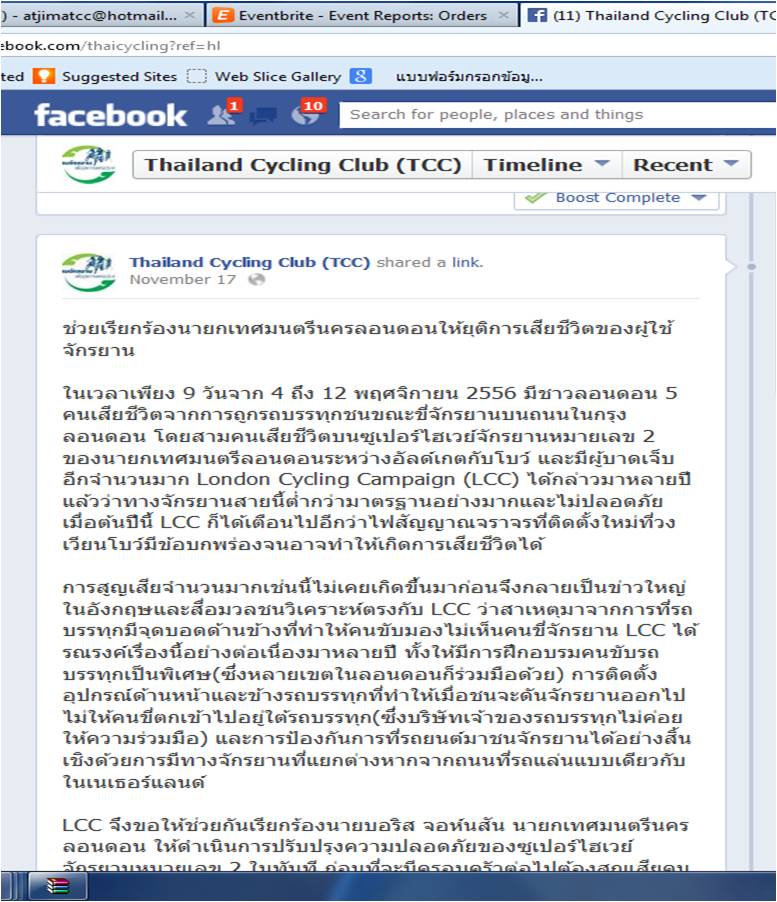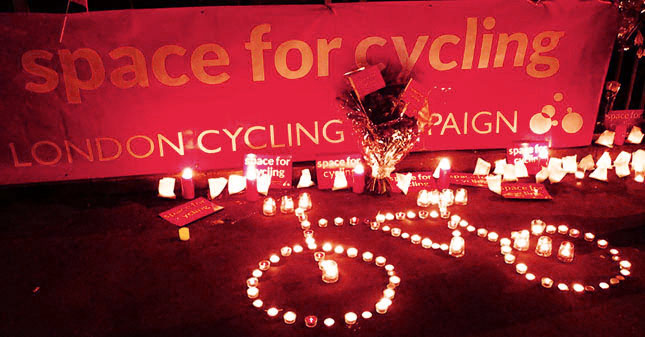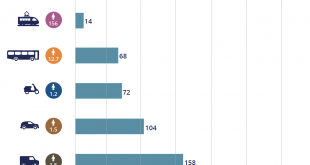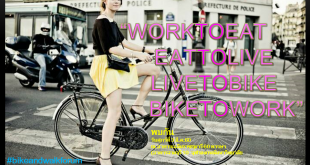————————————————————————————————–

Message from the Mayor of London on Cycle Safety
Dear Sir/Madam
Thank you for writing to me. I share your deep concern about cycle safety in London. That is why I am spending almost £1 billion to provide for cycling, including two fully-segregated superhighways through the heart of central London, remodelling dozens of the most dangerous junctions, and a network of back-street “quietway” routes.
It is why I have promised to upgrade all the existing superhighway routes, with fully or semi-segregated cycle lanes, and to complete all new superhighways to the same standards.
It is why I have plans to turn a number of outer London boroughs into “mini-Hollands”, with large amounts of money spent in relatively small areas to achieve dramatic and transformational pro-cycling change.
It is why I have announced that I intend to impose a substantial and deterrent daily charge on any lorry which is not fitted with basic safety equipment, and why I am also studying time or place-specific lorry bans.
It is why I am using my planning powers to ensure that all new major developments and road schemes are cycle-friendly.
It is why I am paying for free cycle training for any Londoner, adult or child, who wants it; it is why I have appointed a cycling commissioner, making cycling the only transport mode to have its own dedicated representative in my senior staff; and it is why I am recruiting almost 130 extra staff to Transport for London to help deliver my cycling programme.
This is a massive programme of change, which dovetails very closely with what cyclists have been demanding, and I share your impatience to see it delivered. But at the same time, I have promised that we will do it properly, and that cannot happen overnight. If we made changes without working out what to do with the buses, the traffic, deliveries, parking and pedestrians, then we would risk repeating some of the problems of the past.
Nor will I make rushed changes in response to a tragedy which could inadvertently make things more dangerous for cyclists or other vulnerable groups, such as pedestrians – who get a great deal less media attention than cyclists, but are just as important to me. And I own only five per cent of London’s roads; on the others, I can proceed only with the agreement of their owners, usually the London boroughs. But real physical change has already started; our first fully-segregated cycle superhighway was opened earlier this month.
My heart goes out to the victims of these awful accidents and their families and I will do my utmost to learn the lessons from their tragic deaths. But in order to learn the right lessons, it is imperative that we establish the facts of what happened, and avoid jumping to conclusions before we have done so. We should not, for instance, automatically conclude (as so many have) that all or most of these deaths are the fault of the road design. Nor should we automatically assume (as many others have) that they were caused by bad or careless behaviour by the cyclists themselves.
It is my responsibility, and the responsibility of the London boroughs, to provide safer roads for cycling. But, as I have also said, all users of those roads must also take responsibility for using them safely. There is no solution any traffic engineer can devise which will remove that individual responsibility or completely end accidents and deaths.
It is also, I believe, important to separate what are clearly particular problems in particular places, such as Bow roundabout, from the general picture, which is more encouraging. In 2002 there were 110 million cycle journeys in London, of which 20 ended in death. Last year there were 180 million cycle journeys in London, of which 14 ended in death. Over the last ten years, the cyclist death rate per journey in London has more than halved. Despite the terrible recent events, the number of deaths in London in 2013 so far, 14, is the same for the whole of 2012.
I entirely understand why the recent horrific events have obscured these facts. But I am concerned that the all-consuming media and political focus on individual deaths may in fact harm, not help, the cause of cycling in London – by scaring away potential cyclists, and by giving succour to those who say that I and my successors should not encourage cycling as it is, in their view, unsafe.
I am glad to say that I completely disagree with that group of people. I can assure you that cycling is, and will remain, at the heart of my administration. It is, and will remain, one of my highest priorities. These terrible events will only reinforce my determination to make things better for cyclists in London.
Thank you again for your concern.
Yours sincerely
Boris Johnson
Mayor of London
—————————————————————-
 |
http://petition.lcc.org.uk/ea-action/action?ea.client.id=1745&ea.campaign.id=23782&forwarded=true |
หมายเหตุ: ตามที่ London Cycling Campaign (LCC) ได้ขอร้องให้ผู้ใช้จักรยานช่วยกันส่งอีเมลเรียกร้องนายบอริส จอห์นสัน นายกเทศมนตรีนครลอนดอน ให้ดำเนินการปรับปรุงความปลอดภัยของซูเปอร์ไฮเวย์จักรยานหมายเลข 2 ในทันที หลังจากมีผู้ใช้จักรยานเสียชีวิตติดๆ กันห้าคนในเวลาเพียงเก้าวัน (ดู Facebook: Thailand Cycling Club) ศ.ธงชัย พรรณสวัสดิ์ ประธานชมรมจักรยานเพื่อสุขภาพแห่งประเทศไทยได้ส่งอีเมลร่วมเรียกร้องด้วยและได้รับอีเมลตอบกลับมาดังข้างล่างนี้ ชมรมฯจึงขอนำมาลงเผยแพร่เพื่อรับทราบข้อมูลและความเห็นจากผู้บริหารนครลอนดอนในเรื่องความปลอดภัยของการใช้จักรยานในลอนดอนด้วย
อนึ่งผู้แปลได้มีโอกาสสอบถามศาสตราจารย์ปีเตอร์ โจนส์ จาก University College of London ซึ่งเป็นนักวิชาการที่มีชื่อเสียงทั่วโลกในเรื่องการเดินทางที่ยั่งยืน และเป็นที่ปรึกษาของหน่วยงานการขนส่งของลอนดอน (Transport for London) ขณะที่มาบรรยายในไทยเมื่อวันที่ 6 ธ.ค. 56ถึงเรื่องนี้ ศ.โจนส์ให้ข้อมูลที่น่าสนใจหลายประการ ข้อแรกตรงกับนายจอห์นสันว่า ต้องดูภาพรวมว่ายอดการสูญเสียชีวิตของผู้ใช้จักรยานต่อปีมิได้เพิ่มขึ้น ข้อสองโดยเฉลี่ย ผู้ใช้จักรยานในลอนดอนขี่เร็วมากต่างจากผู้ใช้จักรยานในเนเธอร์แลนด์ ข้อสาม ปีที่ผ่านมา มีคนเดินเท้าเสียชีวิตและบาดเจ็บจากการถูกจักรยานชนถึง 150 คน ซึ่งเป็นตัวเลขที่ผู้สนับสนุนการใช้จักรยานไม่พูดถึงและไม่อยากเปิดเผย ในขณะที่สื่อมวลชนไม่สนใจทำข่าวและคนเดินเท้าไม่มีกลุ่มออกมาเรียกร้อง และข้อสี่ ถนนจำนวนมากในลอนดอนเป็นถนนแคบ มีช่องทางจราจรเพียงสองช่องทาง ยากที่จะทำทางจักรยานที่แยกต่างหากจากถนน โดยไม่จำกัดการจราจรของยานพาหนะอื่น โดยเฉพาะรถประจำทาง
กวิน ชุติมา
กรรมการ ชมรมจักรยานเพื่อสุขภาพแห่งประเทศไทย
 ชมรมจักรยานเพื่อสุขภาพแห่งประเทศไทย ชมรมจักรยานเพื่อสุขภาพแห่งประเทศไทย
ชมรมจักรยานเพื่อสุขภาพแห่งประเทศไทย ชมรมจักรยานเพื่อสุขภาพแห่งประเทศไทย



